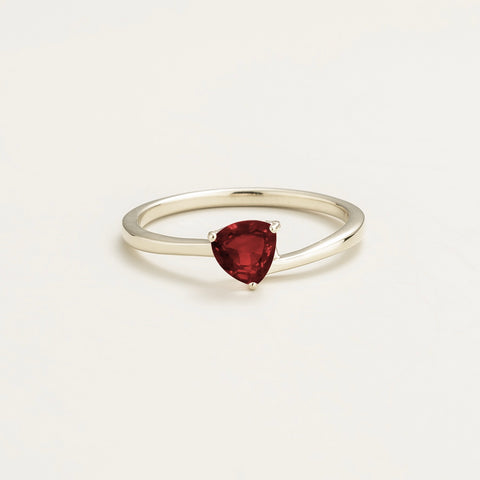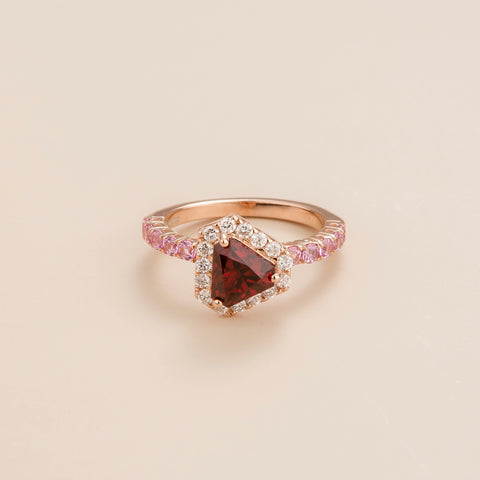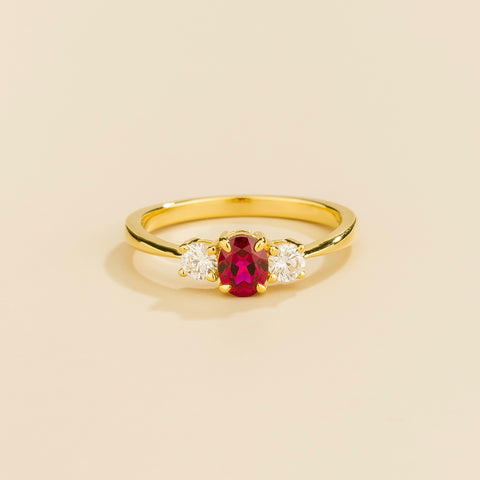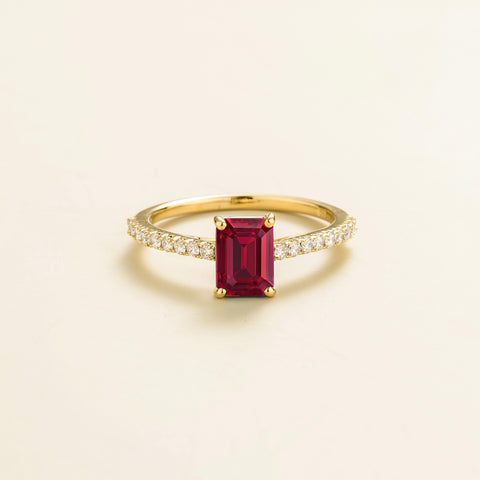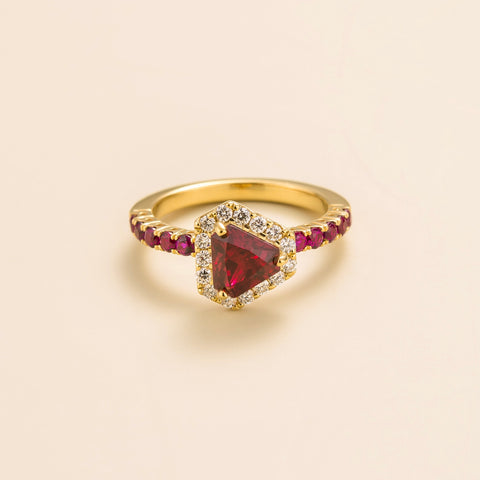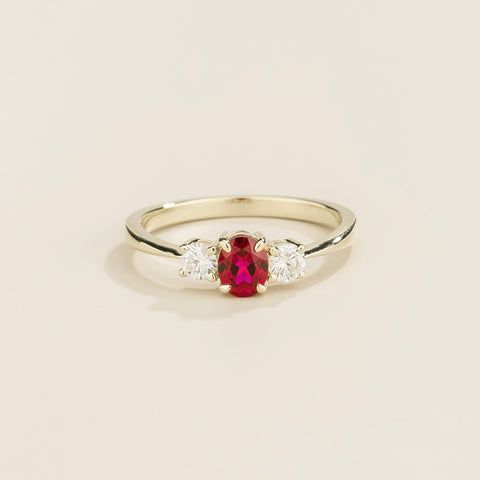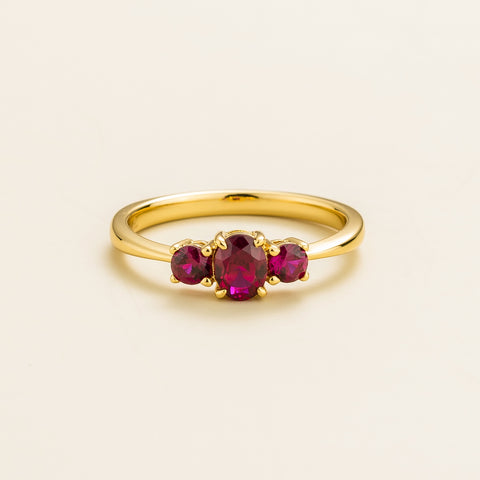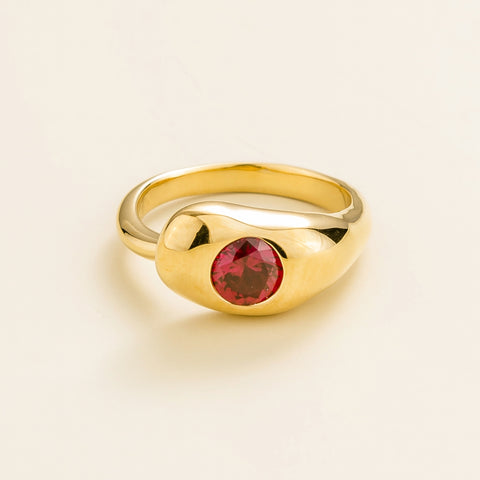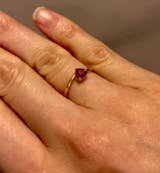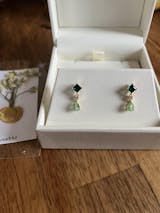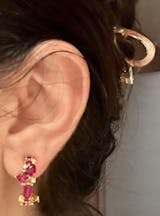
What to Know When Choosing Your Ruby Engagement Ring | 2025 Guide
Table of Content: Inside this Article
...- Understanding Ruby Quality: The Essential Factors
- Colour Options and Comparisons
- Colour Intensity and Tone
- Ruby Grades
- Impact of Lighting on Ruby's Appearance
- Size Comparison: Finding the Perfect Fit
- Clarity Comparison: Understanding Ruby Clarity
- Cut Comparison
- Ethical Considerations in Ruby Selection
- Setting Styles That Enhance Ruby Beauty
- Choosing the Perfect Metal
- White Gold and Ruby Combinations
- Yellow Gold Traditional Appeal
- Rose Gold Romantic Options
- Platinum Durability Benefits
- Sizing and Comfort
- Frequently Asked Questions
If you’re looking for an engagement ring, one with a dazzling ruby stone would be a perfect choice. A ruby engagement ring is a couple’s favourite when showing their love to each other, especially for those who want to make a glowing and romantic statement.
Worn by celebrities like Jessica Simpson, who chose a romantic three-stone ring with a ruby as the central stone, and Katy Perry, who flaunts a striking floral-inspired ruby ring, these gems give a fresh, contemporary alternative to traditional diamonds.
Here’s a complete guide to help you pick the best ruby engagement ring.
Understanding Ruby Quality: The Essential Factors
A ruby's colour is its defining feature, and the right hue can elevate the gem from beautiful to genuinely extraordinary.

Colour Options and Comparisons
Rubies come in a spectrum of red shades, from delicate pinkish-red to deep blood-red. The most prized hue is often called "pigeon’s blood red," a vivid and intense red with subtle bluish undertones, typically found in rubies from Myanmar.
Other regions, such as Mozambique and Thailand, produce exceptional rubies with slightly different colour characteristics. Mozambique rubies often feature a somewhat purplish-red hue, while Thai rubies may lean toward darker, garnet-like tones.
When comparing ruby shades, vibrance and saturation are key. The most desirable rubies have an even distribution of colour, with minimal zoning or fading. Lighter rubies can appear delicate and romantic, while darker stones exude richness and sophistication.
Colour Intensity and Tone
The intensity of a ruby’s colour depends on its saturation and tone. Saturation refers to the purity of the colour, with the most valuable rubies exhibiting vivid, intense saturation. Tone, on the other hand, describes the lightness or darkness of the colour. A balanced medium to medium-dark tone is considered ideal for maximising vibrancy.
Ruby Grades
Rubies are graded based on their colour, clarity, and overall quality, which can significantly influence their appearance:
-
Grade AAA: These stones represent the top 1-10% of rubies. They feature vibrant, rich red hues with medium to medium-dark tones. They exhibit exceptional clarity with minimal inclusions and are often called "investment-grade" rubies. Many lab-grown rubies fall into this top-tier grade. Their vibrant, rich red hues, exceptional clarity, and even colour distribution make them virtually indistinguishable from the highest-quality natural rubies. Because they are created in a controlled environment, inclusions are minimal if present, and colour zoning is rare.
-
Grade AA: Falling within the top 10-20% of rubies, these gems are bright red with good saturation and slightly less vibrancy than AAA. They have high clarity, with only minor inclusions visible under magnification.
-
Grade A: These rubies have medium red tones and may show variations in saturation or lighter/darker areas. Inclusions are more noticeable but do not significantly detract from their overall beauty.
-
Grade B: Typically duller or pale red, these rubies have uneven colour distribution and prominent inclusions that affect their brilliance.
Impact of Lighting on Ruby's Appearance
Lighting conditions can dramatically affect a ruby's appearance. Natural daylight highlights the gem’s colour, while artificial lighting, such as incandescent bulbs, can enhance the stone’s red undertones. Viewing a ruby under different lighting is crucial to fully appreciating its colour and brilliance.
Size Comparison: Finding the Perfect Fit
When choosing a ruby for your engagement ring, size is as important as colour and clarity. The size of the ruby affects not only its visual impact but also its overall value and how it pairs with different ring settings.

Like other gemstones, rubies are measured in millimetres (mm) rather than carat weight alone. This is because rubies are denser than diamonds, meaning a ruby with the same carat weight as a diamond may appear smaller. For example:
-
A 1.0-carat round ruby typically measures around 6.0-6.5 mm in diameter.
-
A 2.0-carat oval ruby might measure approximately 8.0 x 6.0 mm.
-
A 3.0-carat cushion-cut ruby could measure 9.0 mm in length and width.
When shopping, compare ruby sizes with a size chart to get a sense of scale. Many jewellers provide physical or digital charts to help you visualise how the ruby will look in a specific setting. Explore Juvetti’s Rings Collection for various size options and designs for reference.
Clarity Comparison: Understanding Ruby Clarity
Ruby clarity is a critical factor in determining its beauty and value. While inclusions (internal characteristics) are typical in rubies, the type, size, and visibility of these inclusions can significantly impact the gemstone's appearance and market worth.
What Are Inclusions?
Inclusions in rubies are natural imperfections formed during the gem's creation. They can include:
-
Needles: Thin, needle-like mineral inclusions, often arranged in intersecting patterns called "silk."
-
Crystals: Small mineral crystals trapped within the ruby.
-
Colour Zoning: Uneven distribution of colour within the gem.
-
Fissures: Tiny fractures that may reach the gem's surface.
How Clarity Impacts Appearance
-
Visible Inclusions: Large or numerous inclusions can make the ruby appear cloudy, reducing its brilliance and sparkle.
-
Minor Inclusions: Rubies with small, well-dispersed inclusions can still exhibit excellent beauty and are considered high quality.
-
Eye-Clean Rubies: Gems with no visible inclusions to the naked eye are rare and highly valued.
Clarity Grading in Rubies
-
High Clarity (Grade AAA):
-
There are a few inclusions, visible only under magnification.
-
Exceptional brilliance and transparency.
-
Often seen in lab-grown or premium natural rubies.
-
Moderate Clarity (Grade AA):
-
Minor inclusions are visible under magnification, with minimal impact on appearance.
-
Maintains good brilliance and transparency.
-
Noticeable Inclusions (Grade A):
-
Inclusions are more apparent but do not severely detract from the gem’s overall appeal.
-
It is a more affordable option with genuine charm.
-
Heavily Included (Grade B):
-
Prominent inclusions affect transparency and brilliance.
-
Typically used in decorative or costume jewellery.
Natural vs. Lab-Grown Ruby Clarity
Because lab-grown rubies are produced under controlled conditions, they generally have fewer inclusions than natural rubies. This allows them to achieve higher clarity grades, making them an attractive choice for those prioritising brilliance and value.
How to Choose Based on Clarity
-
Opt for a Grade AAA or AA ruby if you want the best brilliance and minimal inclusions.
-
Consider Grade A rubies with fewer noticeable inclusions for a balance of beauty and budget.
-
Always examine the ruby under different lighting conditions to assess its clarity accurately.
Explore exquisite rubies with exceptional clarity at Juvetti’s Ruby Collection.
Cut Comparison
Unlike diamonds, rubies are not graded solely on cut quality, but a well-executed cut can significantly enhance their natural beauty. Below are some popular ruby cuts and their unique characteristics.
Oval Cut
The oval cut is highly regarded for its ability to maximize light reflection, giving the ruby an impressive brilliance. Its elongated shape accentuates the depth of the ruby’s color, making the gemstone appear more vibrant and rich. This versatile cut works beautifully in both classic and modern ring settings, making it a popular choice for those seeking a balance of tradition and contemporary style.
Round Cut
Known for its timeless elegance, the round cut offers unparalleled brilliance thanks to its symmetrical design and precise facets. This circular shape ensures even color distribution, highlighting the ruby’s natural vibrancy. A round-cut ruby is perfect for those who desire a traditional and sophisticated look that never goes out of style.
Cushion Cut
The cushion cut, with its larger facets, is designed to emphasize the ruby’s natural color and brilliance. This cut has a soft, romantic appeal that softens any imperfections and gives the gemstone a luxurious feel. Its vintage-inspired design, coupled with a modern aesthetic, makes it a favorite for those who appreciate a blend of old-world charm and contemporary flair.
Emerald Cut
The emerald cut is celebrated for its understated elegance, focusing less on sparkle and more on the ruby’s clarity and color depth. Its broad, flat facets allow light to reflect evenly, showcasing the gemstone’s true hue. This sophisticated cut is perfect for minimalist designs and those who value bold color over brilliance.
How Cuts Impact Ruby Appearance
A well-cut ruby ensures optimal brilliance, even light reflection, and a stunning overall appearance. Cuts with more facets, such as round and oval, enhance sparkle, while fewer-facet cuts like emerald highlight the stone’s clarity and rich color. Elongated cuts like oval and emerald can make a ruby appear larger than its actual carat weight, adding visual impact without increasing cost.
Your choice of cut depends on your personal preference and the intended style of the ring. For maximum brilliance, opt for round or oval cuts. If you prefer bold color and sophistication, cushion or emerald cuts are excellent choices. Here are finely cut rubies in a variety of shapes you may want to pick.
Ethical Considerations in Ruby Selection
Choosing a ruby engagement ring isn’t just about beauty; it’s also an opportunity to make a socially and environmentally conscious choice. Firstly, traditional ruby mining often involves significant environmental disruption, including deforestation, soil erosion, and water pollution. Additionally, mining practices in some regions may exploit labour and lack stringent regulations, leading to human rights concerns.
In contrast, lab-grown rubies provide an ethical and sustainable alternative to mined gemstones. These rubies are created in controlled environments, requiring fewer natural resources and leaving a minimal environmental footprint. Furthermore, they are conflict-free, ensuring your gem hasn’t contributed to unethical labour practices.
Consequently, Juvetti prioritises sustainability by offering ethically sourced rubies and a wide selection of lab-grown options. By focusing on transparency and environmental responsibility, Juvetti ensures that your ruby sparkles with beauty and aligns with your values.
Certification and Authenticity
When selecting a ruby, verifying its origin and authenticity through reputable certification is essential. Trusted gemological organisations, such as the GIA (Gemological Institute of America), provide detailed reports on a ruby’s quality and ethical sourcing. To learn more about Juvetti's efforts to promote sustainability, visit our Sustainability Story.
Setting Styles That Enhance Ruby Beauty
The correct setting secures your ruby and enhances its natural beauty, complementing its brilliance and making your engagement ring unforgettable. The choice of setting can transform a ruby engagement ring, enhancing its beauty and overall appeal. Here’s a brief guide to some popular setting styles:
Pavé Setting
The pavé setting features tiny diamonds or gemstones encrusted along the band, creating a continuous sparkle. This elegant and versatile design complements solitaires, three-stone rings, and accent gemstone arrangements, adding timeless sophistication.
Four-Prong Setting
A classic and secure choice, the four-prong setting holds the ruby firmly in place while allowing the band’s design and metalwork to shine. This setting beautifully complements the ruby’s shape and cut, providing a clean and balanced look.
Bezel Setting
A popular choice for modern designs, surrounds the ruby with a sleek metal rim. This design enhances durability and protection while offering opportunities for creative styles, such as alternating gemstone shapes. Additionally, the bezel setting can make the centre ruby appear larger, accentuating its vibrant colour and bold presence.
Halo Setting
The halo setting surrounds the ruby with a ring of smaller diamonds or gemstones, amplifying its size and sparkle. This design enhances the ruby’s brilliance and is perfect for those seeking a glamorous and eye-catching ring.
East-West Prong Setting
A contemporary twist by positioning the ruby horizontally along the band, breaking away from the traditional vertical alignment. This innovative design adds a modern and distinctive flair to solitaire rings, making the ruby a bold and stylish focal point. It is particularly well-suited for elongated gemstone shapes like ovals, emerald cuts, and marquises.
Choosing the Perfect Metal
The choice of metal for your ruby engagement ring significantly impacts its overall aesthetic and durability. Each metal brings unique qualities and complements rubies differently, allowing you to personalise your ring to suit your style and needs.
White Gold and Ruby Combinations
White gold provides a modern and sophisticated backdrop for rubies, enhancing their vibrant red hues with its sleek, silvery finish. This combination creates a striking, elegant, and contemporary contrast, making it a popular choice for engagement rings.
Yellow Gold Traditional Appeal
For those who love classic styles, yellow gold offers a warm, timeless charm that pairs beautifully with rubies. The golden tone enhances the richness of the ruby’s colour, creating a luxurious and regal look.
Rose Gold Romantic Options
Rose gold is a favourite for its soft, romantic appeal. The warm pink tones complement the fiery red of rubies, giving the ring a vintage-inspired yet modern feel that resonates with romantic personalities.
Platinum Durability Benefits
Platinum is prized for its strength and hypoallergenic properties. Its naturally white lustre beautifully highlights the ruby’s brilliance while offering exceptional durability, making it ideal for those seeking a lasting, low-maintenance option.
Sizing and Comfort
Ensuring the perfect fit for your ruby engagement ring is crucial for comfort and practicality.
Finding the correct ring size involves more than measuring your finger—it is about considering how the ring will feel during daily wear. Professional sizing at a jeweller or using a reliable tool can help you determine the perfect fit.
Comfort-fit designs are ideal for rings meant to be worn daily. These bands feature a slightly rounded interior that reduces pressure and ensures a smooth, comfortable feel on the finger.
Lifestyle adaptability is another key factor. If you lead an active lifestyle, choosing a design with durable metals and secure settings can help ensure the ring remains comfortable and safe during all activities.
Future sizing possibilities should also be considered, especially for rings that last a lifetime. Opting for a design that allows for resizing, such as those with simple bands, ensures that your ring can be adjusted if your size changes over time.
Frequently Asked Questions
How do I know if a ruby is high quality?
- High-quality rubies exhibit a vivid, even colour, with minimal inclusions that do not affect the stone's brilliance. To ensure authenticity and value, look for consistent saturation, a medium to medium-dark tone, and certifications from reputable gemological organisations.
What's the best setting for a ruby engagement ring?
- The best setting depends on your style and practical needs. Prong settings highlight the ruby’s brilliance, while bezel settings offer maximum protection. Halo settings create a dazzling effect, and three-stone designs add depth and symbolism.
How much should I budget for a ruby engagement ring?
- The cost varies depending on the ruby's quality, size, setting, and metal. High-quality rubies can be more expensive than diamonds of similar sizes. Setting a budget that balances these factors will help you find the perfect ring.
How do I care for my ruby engagement ring?
- Clean your ring regularly with mild soap, warm water, and a soft brush. Avoid harsh chemicals and ultrasonic cleaners. Store your ring in a soft pouch to prevent scratches, and have it professionally checked and cleaned annually. You might also check our complete guide on how to care for your ruby ring.
Can I resize my ruby engagement ring?
- Yes, most ruby engagement rings, especially those with simple bands, can be resized. However, intricate designs may require special attention. Consult your jeweller to understand the resizing options for your specific ring.

